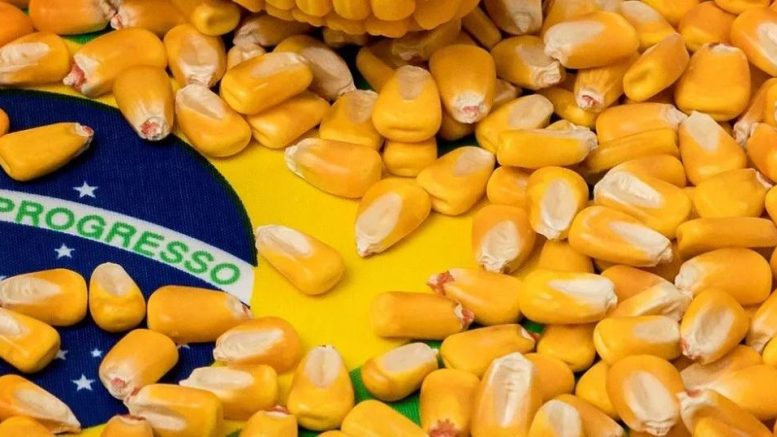“I believe that, in about 10 years, Brazil will be producing much more corn than soybeans...”
Glauber Silveira is the executive director of Brazilian Association of Corn and Sorghum Farmers – Abramilho, with a degree in agronomy from UFMS and a postgraduate degree in agribusiness from FGV.

Glauber Silveira, executive director of Abramilho
AgriBrasilis – What are the possible impacts of the tariffs imposed by the US government?
Glauber Silveira – The tariffs mainly affected beef. Our corn, for example, a lot of it is used for animal consumption, primarily in feedlots, for poultry, pigs, cattle, and sheep. So, if there is any impact on the meat market and this ens up having repercussions, it can affect corn consumption.
Even so, I believe that the impact will not be so significant for corn. The USA tariffs did not focus directly on corn, and, above all, the US is not a competitor with Brazil in the corn market. So, I believe that, in this case, the impact is not as significant as in other cases, such as coffee and orange juice. In the case of corn, Brazil will not be affected that much.
AgriBrasilis – Could China be the path to more growth for the Brazilian corn market?
Glauber Silveira – China is an important market, but it is not the only one. It is not the only contributor to the growth of the Brazilian market. Brazilian corn is exported to about 140 countries, so it is a very broad market.
Brazilian corn goes to many places, to many countries. So, it is not China that will solve our market. Brazil survives and grows without China. In the case of corn, Brazil is not dependent on the Chinese market, nor does Brazil depend on it to grow, because there are other countries with very high demand. Corn is the most produced grain in the world and also the most consumed. In addition, Brazil has ethanol production, human consumption, animal consumption… Corn has a wide range of markets.
China can contribute, of course, but I don’t think it is healthy to depend on a single market, as is the case with soybeans, which depend heavily on the Chinese market. The great advantage of corn is that it is well distributed.
To give you an idea, our largest importer was Iran. And, for just one year, it was China, due to a specific case in which it decided to buy from Brazil.
China is also a major corn producer, larger than Brazil. It produces more than twice what Brazil produces. Of course, it is also a major consumer, but they have an internal policy aimed at increasing productivity and corn production, precisely so as not to depend so much on imports. Therefore, Brazil cannot make its policy or think about the growth of corn in Brazil, depending on the Chinese market.
“Brazil will be the ‘corn country’, probably the largest corn exporter in the world…”
AgriBrasilis – You said that Brazil will be known as “the corn country.” How is Brazil going to get there?
Glauber Silveira – Brazil is already getting there. Brazil already has quite a high production. I believe that in about 10 years, Brazil will be producing much more corn than soybeans. That is the trend. Because, if you think about it, every major corn-farming country produces much more corn than soybeans. Not least because corn is consumed much more than soybeans.
Brazil has enormous potential and still has a lot of room to grow in terms of productivity. Its productivity is not low, but it is not very high either. Brazil has enormous potential to increase yields.
I believe that, in the next 20 years, Brazil will be able to increase production by at least 30% through productivity alone, without increasing the cultivated area. In addition, Brazil has enormous potential for expanding its area.
Brazil is not yet exploiting the full potential of corn production in the second harvest. Brazil is not using everything it has in the winter season. So the country will also grow in terms of area. Many pastures are being incorporated into agriculture: these areas will plant soybeans in the first harvest and corn in the second. So, without a doubt, in the next 20 years, the trend is for us to double corn production in Brazil.
Brazil will be the “corn country”, probably the largest corn exporter in the world. Although the US is the largest producer, it is also the largest consumer. They have a very large ethanol program and consume a lot, reaching about 140 million tonnes of ethanol alone. Therefore, Brazil’s importance is enormous as an exporter and as a supplier to many countries. That is why the world looks to Brazil as an important country in terms of supply. Brazil has a surplus of soybeans, corn, and meat, so it ends up ensuring a certain sustainability for other countries as well.
AgriBrasilis – Will the resources from the new Harvest Plan be sufficient for farmers?
Glauber Silveira – Even if the resources from the Harvest Plan (Brazilian Government agricultural financing plan) were applied in their entirety, it still would not be enough. Brazil needs at least three times more than the amount made available by the Harvest Plan. It is important to remember that what the Federal Government actually contributes is only the amount related to interest equalization. The rest comes from the banks themselves, that is, it is borrowed money that farmers have to pay back. It is not a subsidy.
Farmers need many more resources than the Harvest Plan has offered. That is why other forms of financing are so important. For example, today Brazil has the support of multinationals that also finance production. There are other types of credit outside the Harvest Plan, such as traders who are very active, especially in the Midwest region, offering a barter model, which is the exchange of inputs for future production.
In some cases, these companies also offer credit in dollars, and the farmer deals directly with them, guaranteeing the necessary financing. Therefore, the Harvest Plan is far from meeting the demand on its own. But that does not mean that it is not important: on the contrary, it is fundamental, especially for small and medium-sized Brazilian farmers.
READ MORE:

